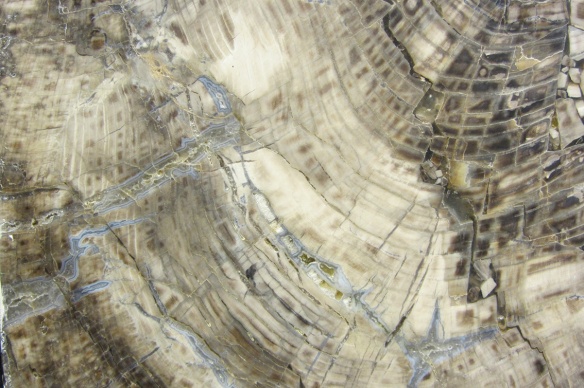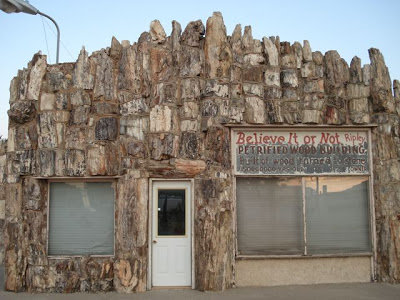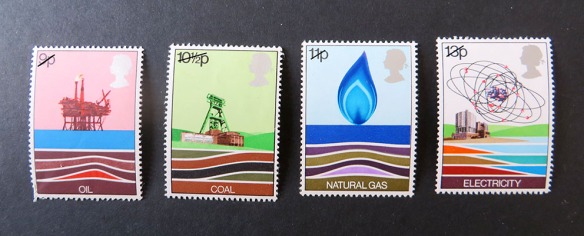This is urban geology at the extreme; petrified wood is not exactly a common building stone, though it is becoming more frequently seen as a decorative stone, used for interior feature walls and even chopping boards and coasters. However it does have a place as a building stone, albeit mostly for novelty purposes … and only in America. Or at least this is the case as far as I am aware.
Silicified or petrified wood is relatively common and always an attractive fossil, with excellent preservation of the wood structure down to cell level. Identification of wood down to species level is often possible from microscopic observation of preserved cell structure. Trees have been around since the Carboniferous but are often much ignored in earth history. They are the background to what are perceived to be more interesting events. Here is an Upper Cretaceous scene whereby a right porker of a Tyrannosaurus is bringing down a green skinny lizard as an amuse bouche, whilst being eyed by circling Pterosaurs. These trees in the background are probably Araucaria sp.

The process of silicification of wood is frequently closely associated with local volcanism. Silica is leached from decaying volcanic ash and carried in groundwaters and stream waters where it can permeate logs and branches. This works particularly well if the logs are buried in ash. Many fossil forest deposits represent preserved log jams in river systems and tree debris becomes silicified in anoxic environments (see Sigleo , 1979). Colours are imparted by trace elements; iron, copper, manganese, even uranium. Black is produced by carbon or finely disseminated pyrite.
Silicified wood deposits are known from Chemnitz in Germany from the Permian Leukersdorf Formation (Luthard et al., 2016) where the coloured stones were used as decorative inlay and as semi-precious gemstones. Also in Europe, deposits occur in Lesvos in Greece (Miocene; see Vasileiadou & Zouros, 2012). Worldwide, silicified wood is known from China (i.e. the Cretaceous ‘Jehol Biota’; see Ding et al., 2016) and exceptionally well-preserved, Pliocene trees are found in Java, Indonesia and Triassic trees occur in Madagascar, and these regions are the origin of most silicified woods on the decorative stone market today (Mandang & Kagemori, 2004; Yoon & Kim 2008). Recent discoveries petrified trees have been made in Brazil (Lower Permian tree ferns; see Maria da Conceiçao et al., 2016) and Turkey (Miocene willows, junipers and oaks; see Akkemik et al., 2016).
 Silicified wood panelling supplied by the Emperors of Stone Bling, Maer Charme. Photo by Ruth Siddall.
Silicified wood panelling supplied by the Emperors of Stone Bling, Maer Charme. Photo by Ruth Siddall.
There are a large number of deposits of various ages in the USA and it is here that fossil trees have largely been used for building. Deposits are known from the Dakotas, Colorado, Oklahoma, Texas etc. The best known deposit is in the Upper Triassic Chinle Formation represents continental facies and outcrops throughout the southwestern USA. These famous fossil conifer deposits occur in the Lower and Upper Petrified Forest Members of Carnian-Norian age. Conifer logs are also found in the intervening Sonsela Member, representative of an alluvial floodplain (see Ash, 1992; Trendell, 2013). However, there are many other examples through the West and Midwest. Many of these deposits have been raided for garden ornaments and other small-scale structures.
A well-known and rather American Gothic building constructed from petrified wood is the (former) gas station in Lamar, Colorado, described by David Williams in his book ‘Stories in Stone’ and also illustrated in his blog. The gas station was built by one William Brown in the 1930s. The Colorado trees are of Cretaceous age but the precise age of strata of origin is unknown. The ‘logs’ were found in fluvial outwash in farmland around 25 miles south of Lamar.
 Lamar Gas Station; photo from Geologywriter.com
Lamar Gas Station; photo from Geologywriter.com
And then there is Petrified Wood Park in Lemmon, South Dakota, also constructed in the 1930s. This is a truly terrifying place; cones, pinnacles, pyramids and creepy-looking grotto-like buildings are built from petrified wood as well as dinosaur and mammoth bones. The park occupies a whole block of the town and was built by amateur geologist and ‘visonary’ Ole S. Quammen. To be fair his intention was altruistic, it was to provide work for 50 or so otherwise unemployed men during the depression era West. Quammen’s heirs donated the park to the grateful town of Lemmon in 1954 where it remains ‘the world’s largest petrified wood park of its kind’. Obviously. An on-site museum once house a collection of stuffed animals playing musical instruments. Sadly, these are no longer on display. The petrified wood was sourced locally, potentially from several strata. The Early Cretaceous Lakota Sandstone Formation outcrops in the eastern Black Hills and has fossilised logs of cypress, palm and cycads. The Hell Creek Formation of South Dakota also has petrified Late Cretaceous cypress (and dinosaurs). The Palaeocene petrified wood is found in the Badlands of South Dakota where conifers and broadleaf tree trunks and branches are preserved (Teachout, 1995).
 Lemmon Petrified Wood Park sign; photo from SouthDakota.com
Lemmon Petrified Wood Park sign; photo from SouthDakota.com
According to Snider (2012), Texas is the state for construction in petrified wood, and she cites Austin, Huntville, Decatur (which also has a petrified wood gas station) and Stephenville as all having buildings incorporating this unexpected stone. However, the town of Glen Rose in Somerville County has over 40 buildings and other structures constructed of silicified wood. It was once known as ‘The Petrified City’. The post office, several houses, fountains, a (now disused and ruined) speakeasy and the bandstand are all built from petrified wood. The bandstand also incorporates slabs with spectacular dinosaur footprints too.
 The ruins of Glen Rose’s speakeasy; photo by Tui Snider (2013)
The ruins of Glen Rose’s speakeasy; photo by Tui Snider (2013)
 Bandstand, Glen Rose, Texas; photo by Tui Snider (2012)
Bandstand, Glen Rose, Texas; photo by Tui Snider (2012)
 Detail of dinosaur footprint in Glen Rose’s bandstand; photo by Tui Snider (2012)
Detail of dinosaur footprint in Glen Rose’s bandstand; photo by Tui Snider (2012)
The origin of this Texan petrified wood building spree, which occurred in the 1920s and 30s was a unexpected consequence of the mechanisation of agricultural machinery. Farmers were able to dig deeper into their soils than before and they hit a petrified wood motherlode in the local fields. The logs were hauled out and used to build the town.
Finally, the most attractive structure built from petrified wood is not all scary. It is Agate House, located in the Petrified Forest National Park, Arizona. It was originally constructed between 1050 and 1300 AD by Ancestral Puebloans from Triassic Chinle Formation petrified trees. Other examples of structures built from petrified wood have also been excavated in the surrounding region, since the 1930s. The excavation of Agate House and its subsequent reconstruction was overseen by archaeologist Cornelius Burton Cosgrove Jr. (1906 – 1999). Petrified wood was also used for arrowheads and similar artefacts by the Ancestral Puebloans.
![agate-house-1[6]](https://orpiment.files.wordpress.com/2017/04/agate-house-16.jpg?w=584) Above, Agate House; photo by Amusing Planet
Above, Agate House; photo by Amusing Planet
 Above, the wall of Agate House; photo by NotsofastinBoulder’s Blog.
Above, the wall of Agate House; photo by NotsofastinBoulder’s Blog.
More petrified wood buildings in the USA …
Gas Station, Decatur, Texas
Carter County Museum, Montana – does anyone have a photo of this? It is partially built of Hell Creek Formation wood.
Petrified wood and petrified wood buildings in Oklahoma
Outside the USA …
The town of Mata – “Cidade da Pedra que foi madeira” (“The city of rocks that once were wood.”) – in Rio Brande do Sul, Brazil. Petrified wood from the Upper Triassic Caturrita Formation is used to build several buildings and can be seen in the Palaeobotanical Garden. The fossils were collected by priest and palaeontologist Daniel Cargnin.
 Thanks to Christian Kammerer @Synapsida for this information and photos.
Thanks to Christian Kammerer @Synapsida for this information and photos.
If anyone knows of any more structures built of petrified wood outside the US, do let me know …
How to cite this blog:
Siddall, R., 2017, First I was afraid, I was petrified … A short history of scary silicified log cabins., Orpiment Blog https://orpiment.wordpress.com/2017/04/13/first-i-was-afraid-i-was-petrified-a-short-history-of-scary-silicified-log-cabins/
References
Akkemik, Ü., Arslan, M., Poole, I., Tosun, S., Köse, N., Kiliç, N. K. & Aydin, A., 2016, Silicified woods from two previously undescribed early Miocene forest sites near Seben, northwest Turkey., Review of Palaeobotany and Palynology 235., 31–50.
Ash, S.R. and Creber, G.T., 1992. Palaeoclimatic interpretation of the wood structures of the trees in the Chinle Formation (Upper Triassic), Petrified Forest National Park, Arizona, USA. Palaeogeogr., Palaeoclimatol., Palaeoecol., 96:299 317.
Ding, Q., Tain, N., Wang, Y., Jiang, Z., Chen, S., Wang, D., Zhang, W., Zheng, S., Xie, A., Zhang, G. & Liu, Z., 2016, Fossil coniferous wood from the Early Cretaceous Jehol Biota in western Liaoning, NE China: New material and palaeoclimate implications., Cretaceous Research, 61, 57-70.
Mandang, Y. I. & Kagemori, N., 2004, A Fossil Wood of Dipterocarpaceae from Pliocene Deposit in the West Region of Java Island, Indonesia., Biodiversitas, 5(1), 28-35.
Maria da Conceiçao, D., Saturnino de Andrade, L., Cisneros, J. C., Iannuzzi, R., Pereira, A. A. & Machado, F. C., 2016, New petrified forest in Maranhao, Permian (Cisuralian) of the Parnaíba Basin, Brazil., Journal of South American Earth Sciences 70, 308-323.
Petrified Wood Park, Lemmon, South Dakota.
Petrified Woods from the Indonesian Islands of Java and Sumatra.
Saltarelli, M, G., 2009, ‘Irreplaceable Works of Art’: Petrified wood treasures and dinosaur tracks create a paradise of geology.
Sigleo, A.C., 1979. Geochemistry of silicified wood and associated sediments, Petrified Forest National Park, Arizona. Chem. Geol., 26: 151–163.
Snider, T., 2012, Texas Road Trips: From Dinosaurs to Drive-Ins.
Snider, T., 2013, A to Z Texas: P is for Petrified Wood Buildings.
Teachout, G. E., 1995, Petrified wood of South Dakota.
Trendell, A. L., Nordt, L. C., Atchley, S. C., Lebland, S. L. & Dworkin, S. I., 2013, Determining floodplain plant distributions and populations using paleopedology and fossil root traces: Upper Triassic Sonsela Member of the Chinle Formation at Petrified Forest National Park, Arizona., Palaios, 28, 471-490.
University of Arizona, Laboratory of Tree-Ring Research; Fossil Trees or Petrified Wood.
Vasileiadou, K. & Zouros, N., 2012, Early Miocene micromammals from the Lesvos Petrified Forest (Greece): preliminary results., Palaeobio. Palaeoenv., 92, 249–264.
Williams, D. B., 2009, Chapter 7: Pop rocks, pilfered fossils and Phillips Petroleum – Colorado Petrified Wood., Stories in stone: travels through urban geology., Walker Publishing Inc., New York., 133-151. & Blog.
Yoon, C. J. & Kim, K. W., 2008, Anatomical descriptions of silicified woods from Madagascar and Indonesia by scanning electron microscopy., Micron 39, 825–831.



 Silicified wood panelling supplied by the Emperors of Stone Bling,
Silicified wood panelling supplied by the Emperors of Stone Bling,  Lamar Gas Station; photo from
Lamar Gas Station; photo from 
 The ruins of Glen Rose’s speakeasy; photo by
The ruins of Glen Rose’s speakeasy; photo by  Bandstand, Glen Rose, Texas; photo by
Bandstand, Glen Rose, Texas; photo by  Detail of dinosaur footprint in Glen Rose’s bandstand; photo by
Detail of dinosaur footprint in Glen Rose’s bandstand; photo by ![agate-house-1[6]](https://orpiment.files.wordpress.com/2017/04/agate-house-16.jpg?w=584) Above, Agate House; photo by
Above, Agate House; photo by  Above, the wall of Agate House; photo by
Above, the wall of Agate House; photo by 






















































 series of five works entitled ‘The spirits that lend strength are invisible I-V’. Inspired by the ancient land and native peoples of America (Garrels, 2010), these works used a variety of materials and media, including powdered nickel, silver leaf and silver oxides, artificial resins and even Neolithic stone tools (in V, left). Perhaps most striking in terms of materiality is ‘The spirits that lend strength are invisible II’ which is a scatter of powdered meteorite dust dispersed onto artificial resin. This painting, currently on tour with the exhibition Alibis: Sigmar Polke 1963-2010 belongs to The Doris and Donald Fisher Collection.
series of five works entitled ‘The spirits that lend strength are invisible I-V’. Inspired by the ancient land and native peoples of America (Garrels, 2010), these works used a variety of materials and media, including powdered nickel, silver leaf and silver oxides, artificial resins and even Neolithic stone tools (in V, left). Perhaps most striking in terms of materiality is ‘The spirits that lend strength are invisible II’ which is a scatter of powdered meteorite dust dispersed onto artificial resin. This painting, currently on tour with the exhibition Alibis: Sigmar Polke 1963-2010 belongs to The Doris and Donald Fisher Collection.
